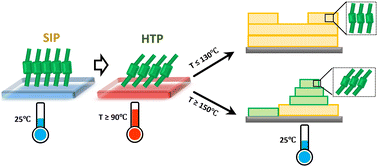Temperature-induced polymorphism of a benzothiophene derivative: reversibility and impact on the thin film morphology†
Abstract
The identification of polymorphs in organic semiconductors allows for establishing structure-property relationships and gaining understanding of microscopic charge transport physics. Thin films of 2,7-bis(octyloxy)[1]benzothieno[3,2-b]-benzothiophene (C8O–BTBT–OC8) exhibit a substrate-induced phase (SIP) that differs from the bulk structure, with important implications for the electrical performance in organic field effect transistors (OFETs). Here we combine grazing incidence wide-angle X-ray scattering (GIWAXS) and atomic force microscopy (AFM) to study how temperature affects the morphology and structure of C8O–BTBT–OC8 films grown by physical vapor deposition on SiO2. We report a structural transition for C8O–BTBT–OC8 films, from the SIP encountered at room temperature (RT) to a high temperature phase (HTP) when the films are annealed at a temperature T ≥ 90 °C. In this HTP structure, the molecules are packed with a tilt angle (≈39° respect to the surface normal) and an enlarged in-plane unit cell. Although the structural transition is reversible on cooling at RT, AFM reveals that molecular layers at the SiO2 interface can remain with the HTP structure, buried under the film ordered in the SIP. For annealing temperatures close to 150 °C, dewetting occurs leading to a more complex morphological and structural scenario upon cooling, with coexistence of different molecular tilts. Because the molecular packing at the interface has direct impact in the charge carrier mobility of OFETs, identifying the different polymorphs of a material in the thin film form and determining their stability at the interfaces are key factors for device optimization.



 Please wait while we load your content...
Please wait while we load your content...